
Sushi can be divided into five different categories. They are shiromi-dane (white meat), akami-dane (red meat), hikari-mono (shiny skin), ni-mono (braised) and hokano-mono which is all the other stuff like squid, crabs, uni and our topic for today, kai 貝 (shellfish).
Chef Ashino tells me that spring is the best season for shellfish which are an essential tane (topping) at the sushi bar but usually play a supporting role to superstars like uni and otoro. However, any sushi meal would not feel complete without some shellfish. Unlike finfish whose flavour improves with aging, shellfish are never aged because of the risk of food poisoning and must be consumed either very fresh or cooked. Shellfish are packed natural occurring glutamate and other amino acids which make them a really tasty treat.
Today we will look at some of the delectable shellfish that come into season during spring!
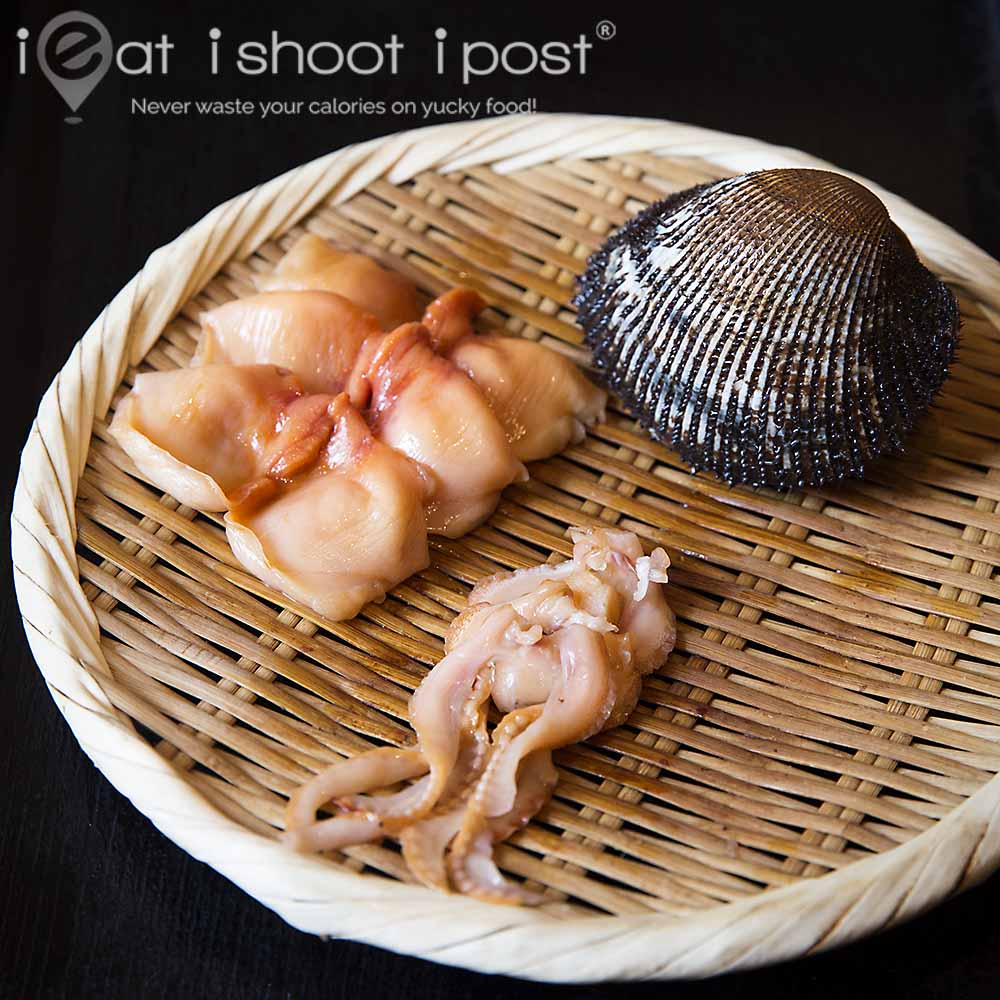
Akagai 赤貝
Ark Shell, Blood Clam, Blood Cockle
Scapharca broughtonii
The akagai is one of the most attractive shellfish in the sushi repertoire. It has an unmistakable orangey red hue due to the presence of haemoglobin, the same iron compound which gives blood its bright red colour, hence its name, blood cockle. It resembles our local cockles but they are much larger and the flavour is milder. The shell has distinctive ridges that give it a furry greyish-brown appearance.

When you order akagai, the chef will often throw the flesh onto the cutting board to tighten it and then score the surface multiple times to make it easier to chew and also to enable the tane to mold nicely onto the rice. Because of this iconic presentation, it is sometimes referred to as “butterfly mussel” 蝶貝.
Akagai is sweet and crunchy but it is the characteristic aroma that develops at the back of the palate on chewing that draws many sushi enthusiasts to this mollusc in spring. This unique bouquet can only be appreciated from top grade akagai which has become more expensive of late due to its diminishing supply. The himo or mantle around the main body of the mollusc can be eaten and is actually preferred by some who relish its crunchy texture.
The flavour for ark shell peaks from February to March just before spawning season and as with many sushi items, the best Ark Shells are harvested from the waters around Japan. Yuriage in Miyagi Prefecture is one place famed for this shellfish harvest. Akagai being harvested from other countries but the top sushi bars will always insist on using only the ones from Japan.
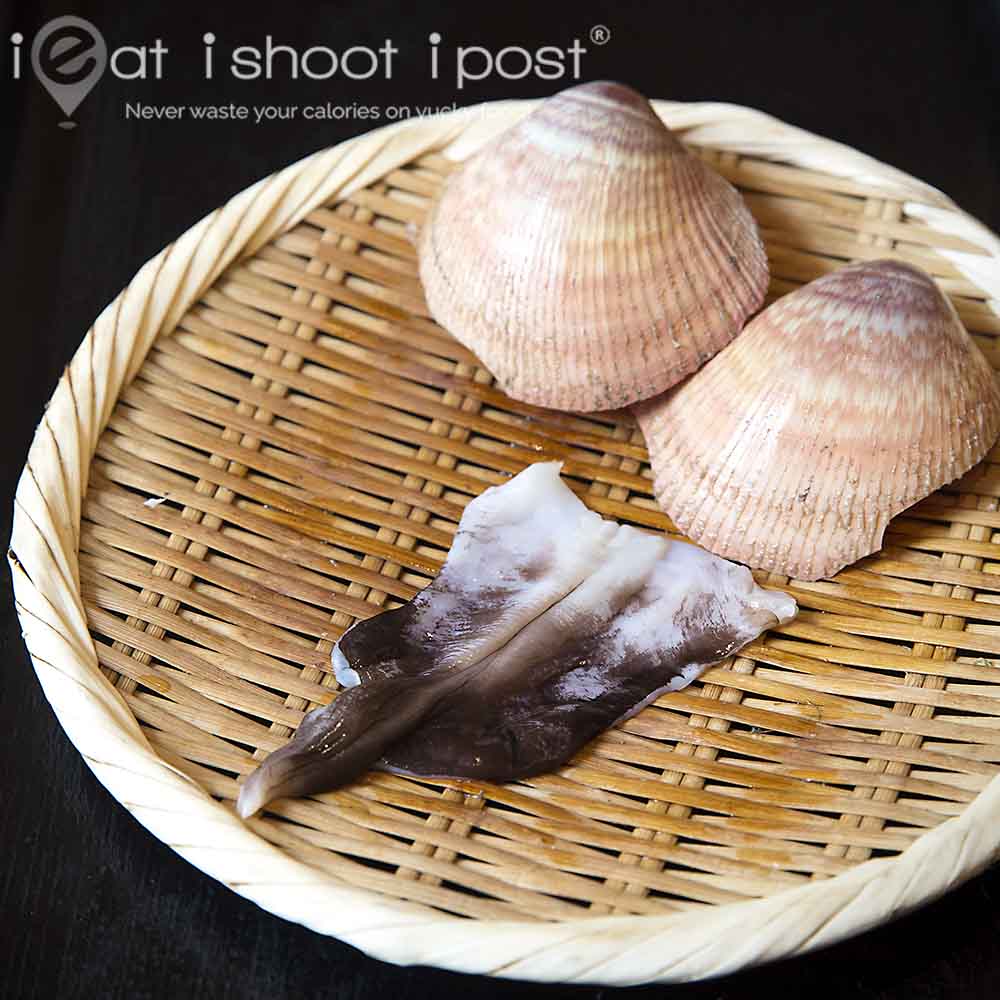
Torigai 鳥貝
Heart Clam, Bird Clam, Beakneck Clam
Fulvia mutica
There are very few dark coloured items on the sushi menu, so the dark purplish colour of the torigai is quite unmistakable. This particular clam needs to be eaten absolutely fresh and are usually sourced live in the shell, so it is one of those tane that is only found in top sushi restaurants. To demonstrate its freshness, the taisho would often throw it onto the chopping board to demonstrate that the flesh is still “live”. (See video below)
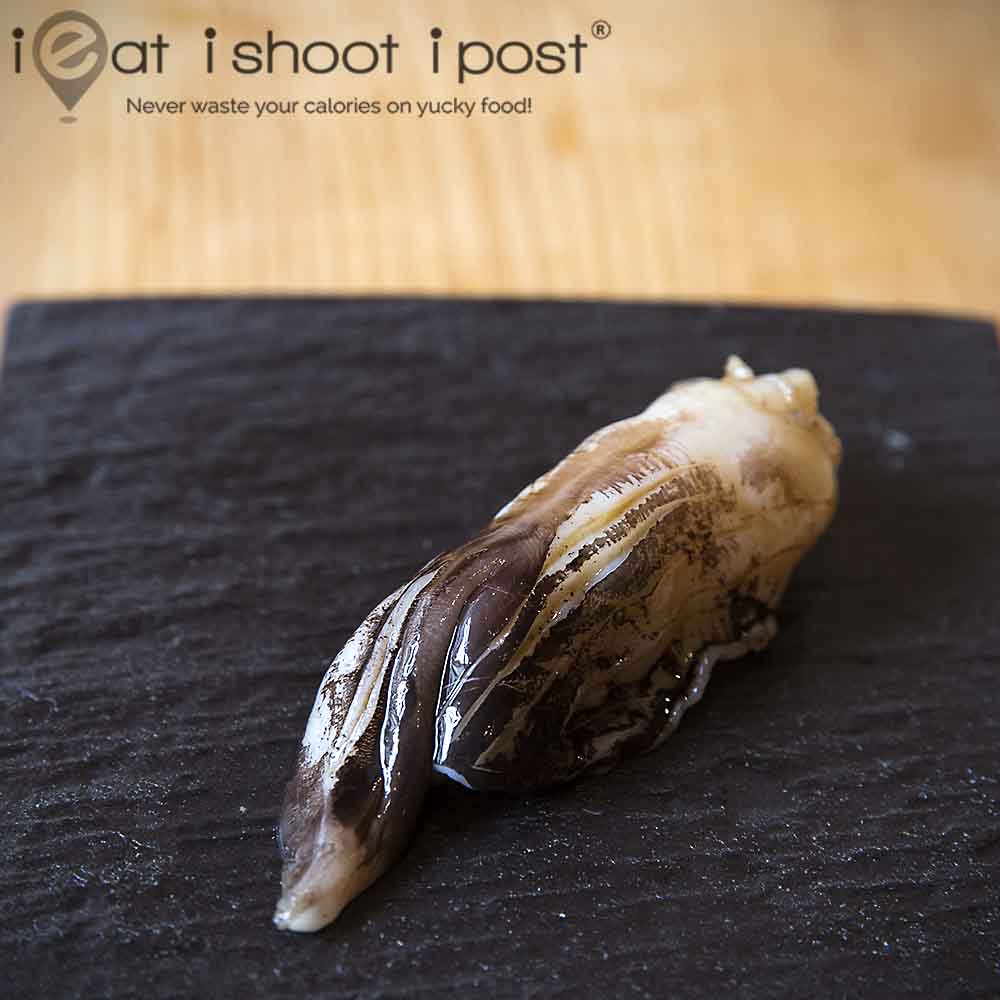
This shellfish grows to approximately 10cm. The edible portion is the purplish “foot” which is said to resemble a bird’s beak, hence the name “tori-gai” which literally means “chicken clam”. Another theory is that it is so called because it tastes like chicken. I have eaten this a few times, and it tastes nothing like chicken, so I am not sure if this theory is valid.
The freshness of the clam is indicated by the depth of its dark purplish hue. They can be harvested from the coastal waters of Aomori up north all the way down to Kyushu in the south. The season is between Mar and July but those caught between April and May are particularly large and sweet.
Its flesh is supple and chewy and a quick blanch in hot water or light grilling over binchotan will intensify its aroma and flavour.
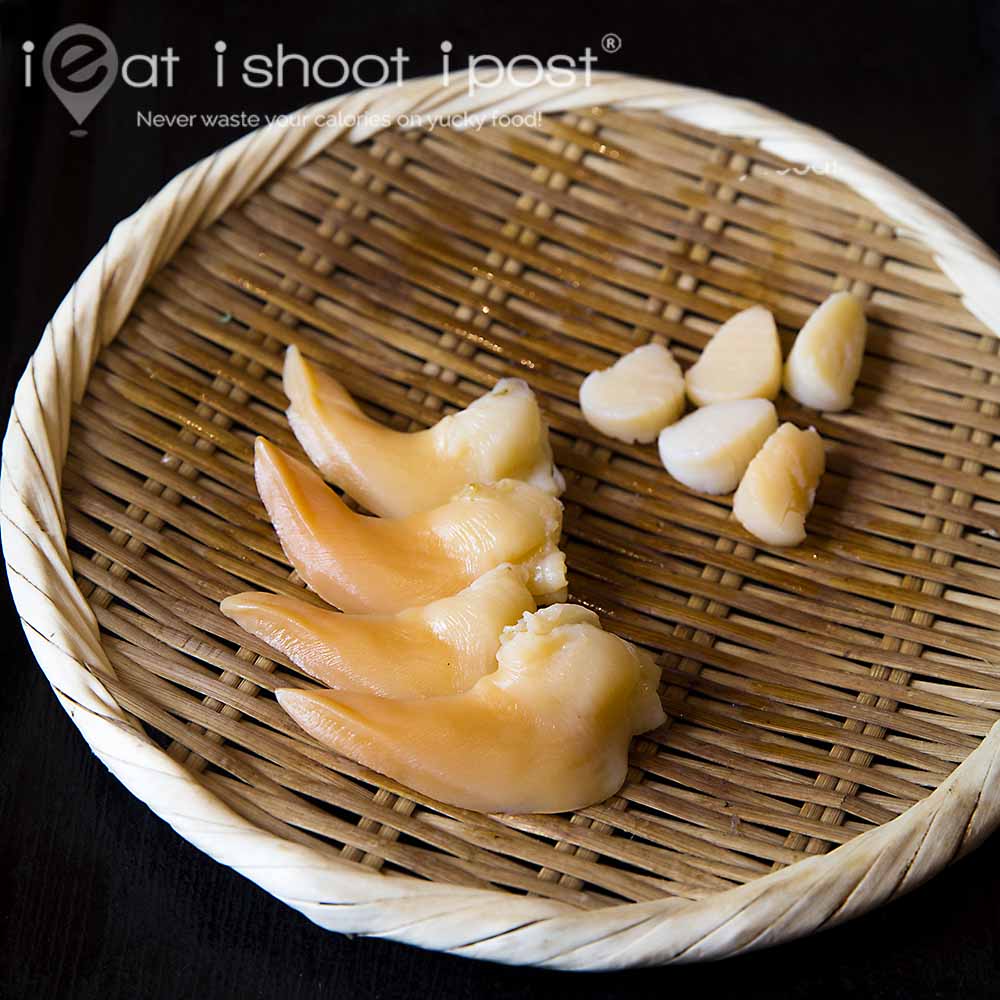
Aoyagi,(青柳 アオヤ), Bakagai
Hen clam, Round Clam, Chinese Mactra Clam
Mectra chinensis
The proper name for this clam is “bakagai” or literally, idiot clam. It probably got its name from semblance of the bright orange foot sticking out of the clam to a cheeky boy sticking out his tongue. The word “baka” is considered to be a little rude and even low class, so it is called Aoyagi instead, after the town in Chiba which was the principle harvesting grounds during the Edo period.
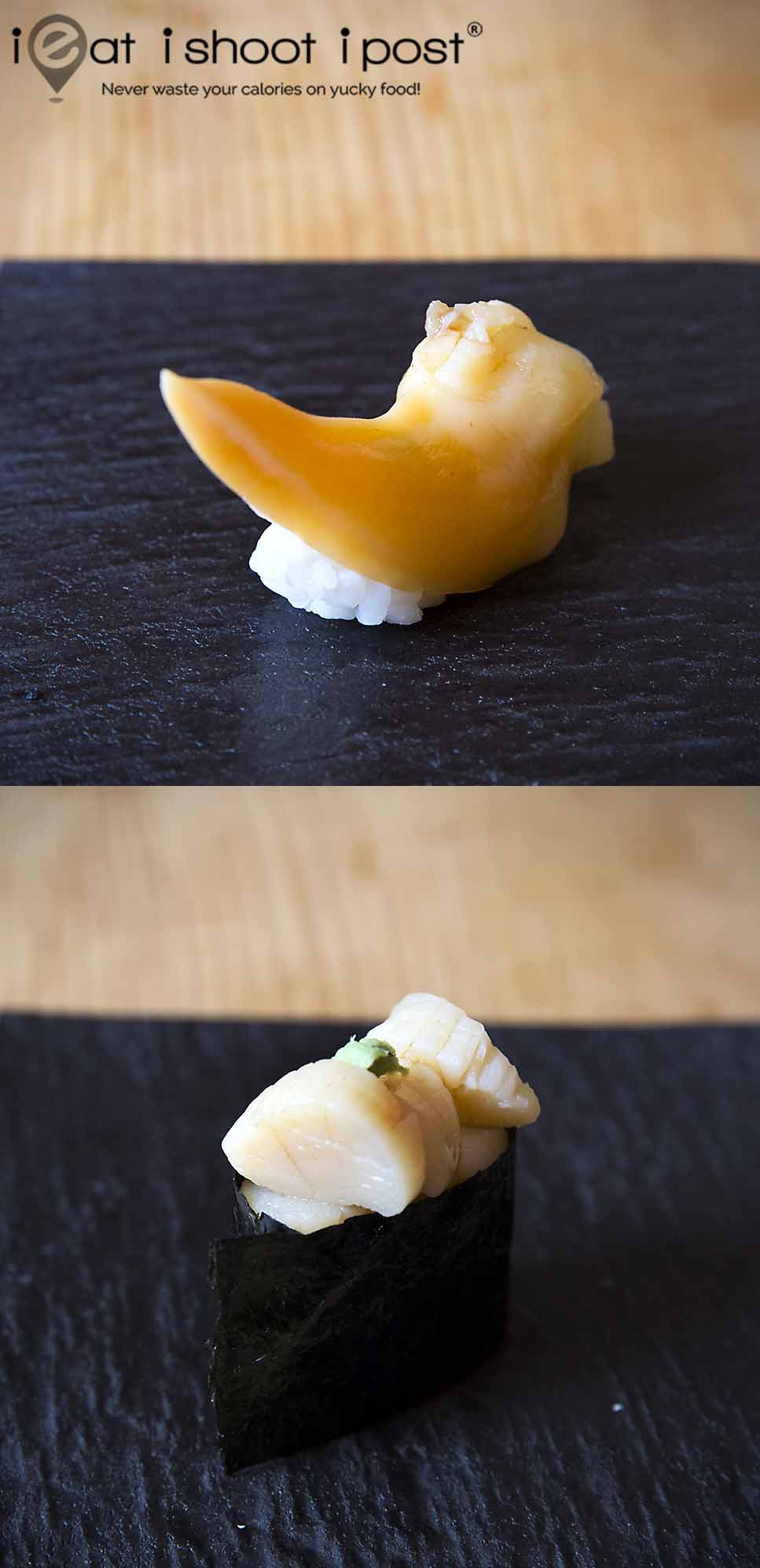
Aside from its characteristic bright orange colour, this particular shellfish is distinguished from the others by the presence of two adductor muscles or kobashira. The larger one is called ohboshi and the smaller one koboshi. This is the prized part of the shellfish and the Sushi chef will collect enough from several shellfish in order to top a gunkan sushi for valued customers.
The kobashira have a similar texture to tairagai and is very pleasant and sweet. The foot itself is pleasant but not considered a delicacy. It isn’t nearly as sweet as the adductor muscles which can cost five times more than the tongue itself.
Aoyagi are at their peak from winter to early spring before they start spawning in June.
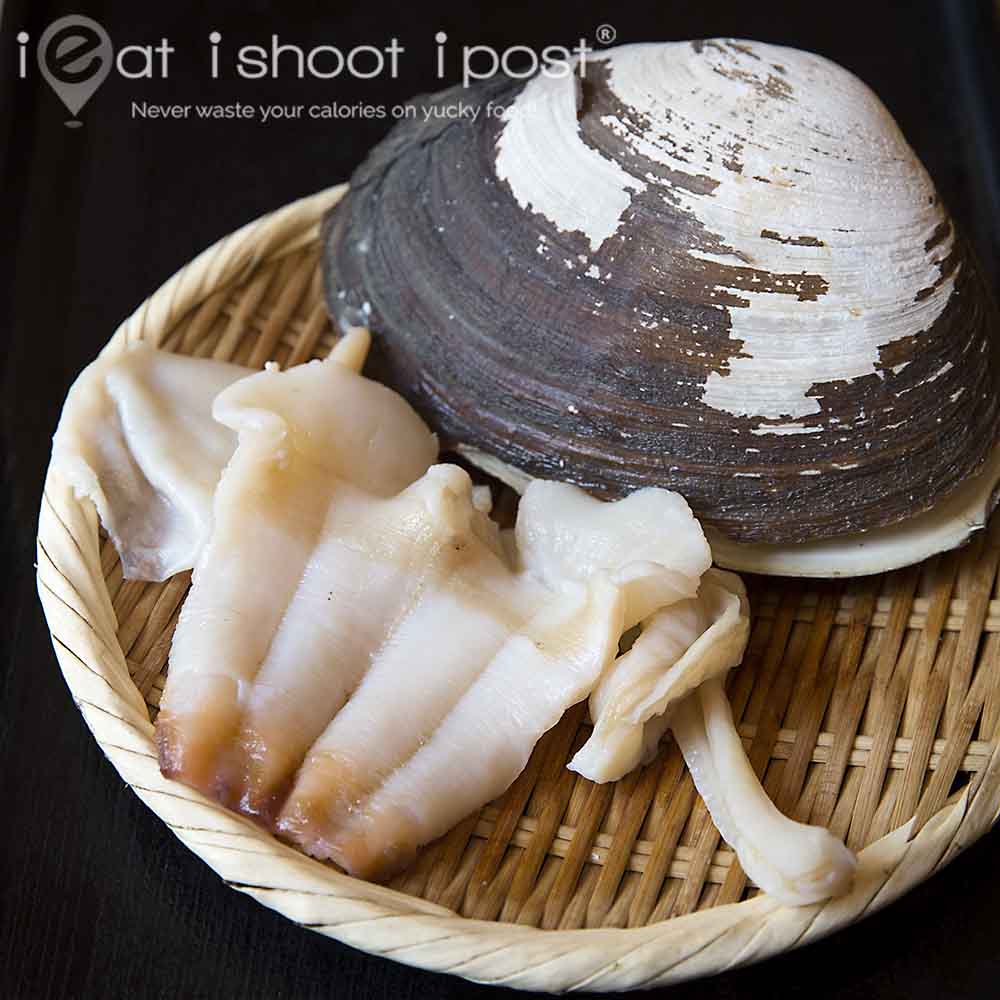
Mirugai -海松貝
Mirugai clam, Pacific Gaper, Geoduck,
Treesus keenae
The first thing you should know about geoduck is that it is pronounced “gooeyduck”. The name comes from a native American word meaning “dig deep”. The second thing is that this is a not a special breed of duck…… but that should be quite obvious by now.
Geoduck is regarded as one of the luxury clam, second only to awabi (abalone). It has two flavour peaks in a year, once in March and then another in October. These large molluscs are distinguished by their phallic like siphon which is the only part of the clam that is used for sushi. The proper name in Japanese is mirukui which literally means “eater of miru”. Miru is a type of seaweed known as the sea staghorn which the clam eats. Over the years, its name got morphed into mirugai.
The true Japanese geoduck, treesus keenae, are a smaller species than their larger cousins, panopea generosa which are harvested from Canada and the northwestern coast of the USA. Sushi chefs serving Japanese geoduck will are refer to them as honmiru ie “true miru”. These large borrowing clams live on rocky shelves along the coast of Japan from Hokkaido to Kyushu. Their harvest have dropped over the years and many sushi places now import its larger cousin as a substitute. It goes without saying that Chef Ashino only serves honmiru at his restaurant and he tells me that this is his favourite clam.
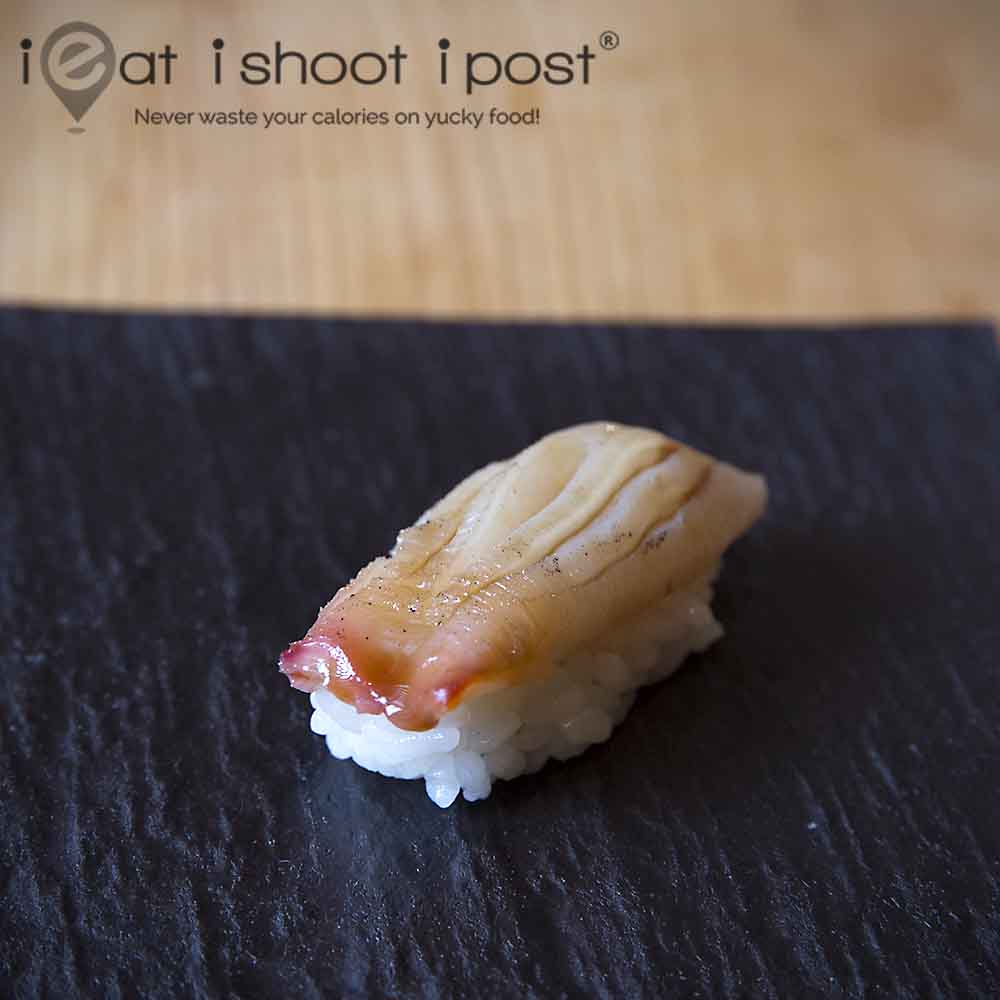
Mirugai can live up to 150 years and the shell can grow up to 15cm across. (The Canadian variety grows up to 20cm) They borrow deep into the sand at a rate of 1 foot a year and remain about 3 feet underground, extending its siphon upwards above the sand to feed.
To prepare the sushi, the siphon is first dipped into boiling water and then the dark, wrinkly skin is removed to reveal the ivory coloured meat. Each siphon can be made into four pieces of sushi. Fresh mirugai is crunchy and has a strong flavour which is often liken to that of a crisp sea breeze. They have traditionally be thought to be an aphrodisiac due to their shape, but interestingly scientists have shown that their high amino acid content is not only responsible for their deep umami flavour but it also helps to release sex hormones! It is also high in zinc which is a required in males for spermatogensis.
So, it looks like grandma might have been on to something!
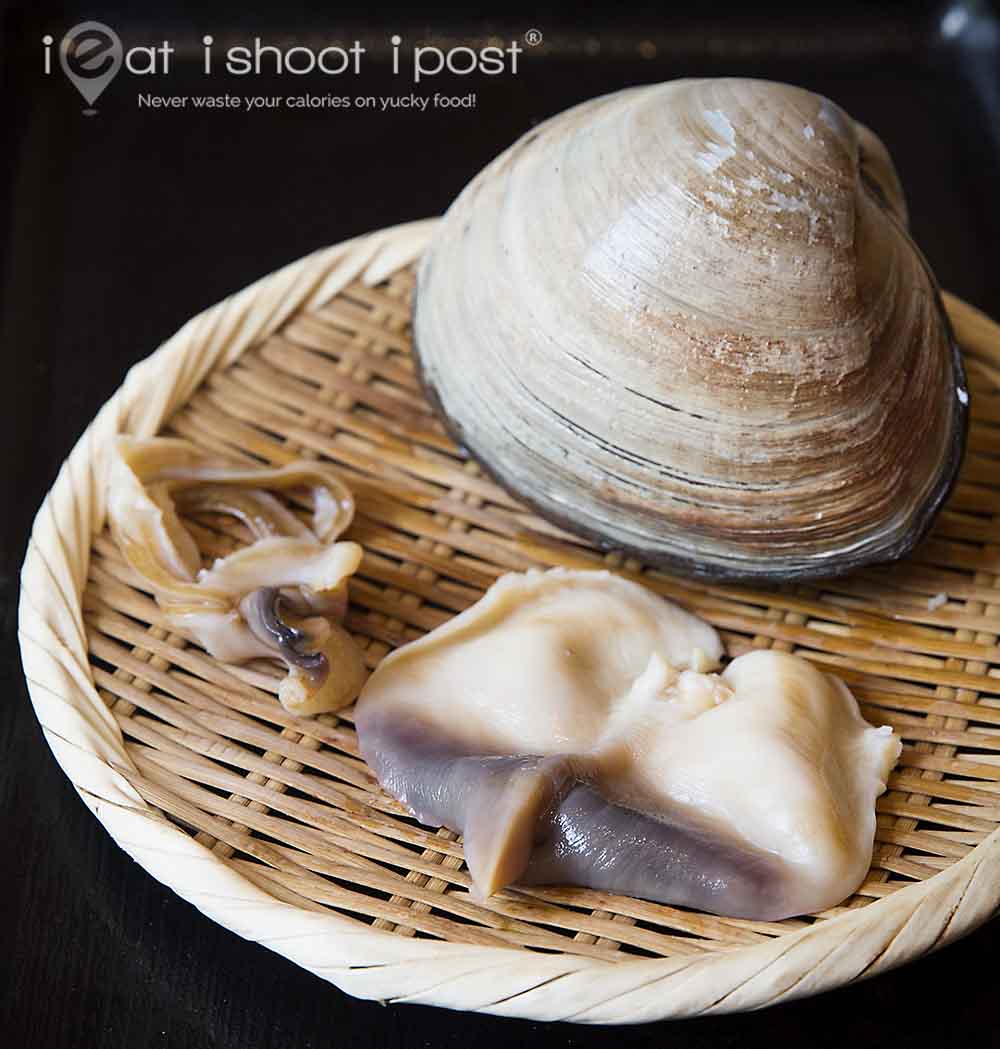
Hokkigai 北寄貝, Ubagai-姥貝
Japanese Surf Clams, Sakhalin Surf Clam
Pseudocardium sachalinense
Speaking of granmas, the proper name for hokkigai is actually ubagai which is literally “granny” clam. It is so called because of the wrinkly lines on its shell which gives it an aged appearance. Each line denotes one year of growth and this shellfish can grow up to 30 years old!

“Hokkigai” can be roughly translated as the “clam from the north”. It is harvested north of the Pacific coast of Kashimanada in the Ibaraki prefecture and the northern coasts of the Sea of Japan, as far as the Siberian coast. Seventy percent of the shellfish is harvested from Hokkaido and a large volume comes from the city of Tomakomai where it has been designated as the city’s clam.
The foot of the clam is the part used for sushi. It is ivory coloured with a pale purplish hue at the end which turns into a pretty crimson when the clam is cooked. This quick blanching process, known as yuburi or yufuri, will also rid the clam of its mildly offensive aroma. Although it doesn’t have the fragrance of akagai, it is sweet and flavourful. These clams can also be harvested from other parts of the world and the cheaper bright red pre-cooked versions can often be found at conveyor belt sushi restaurants.
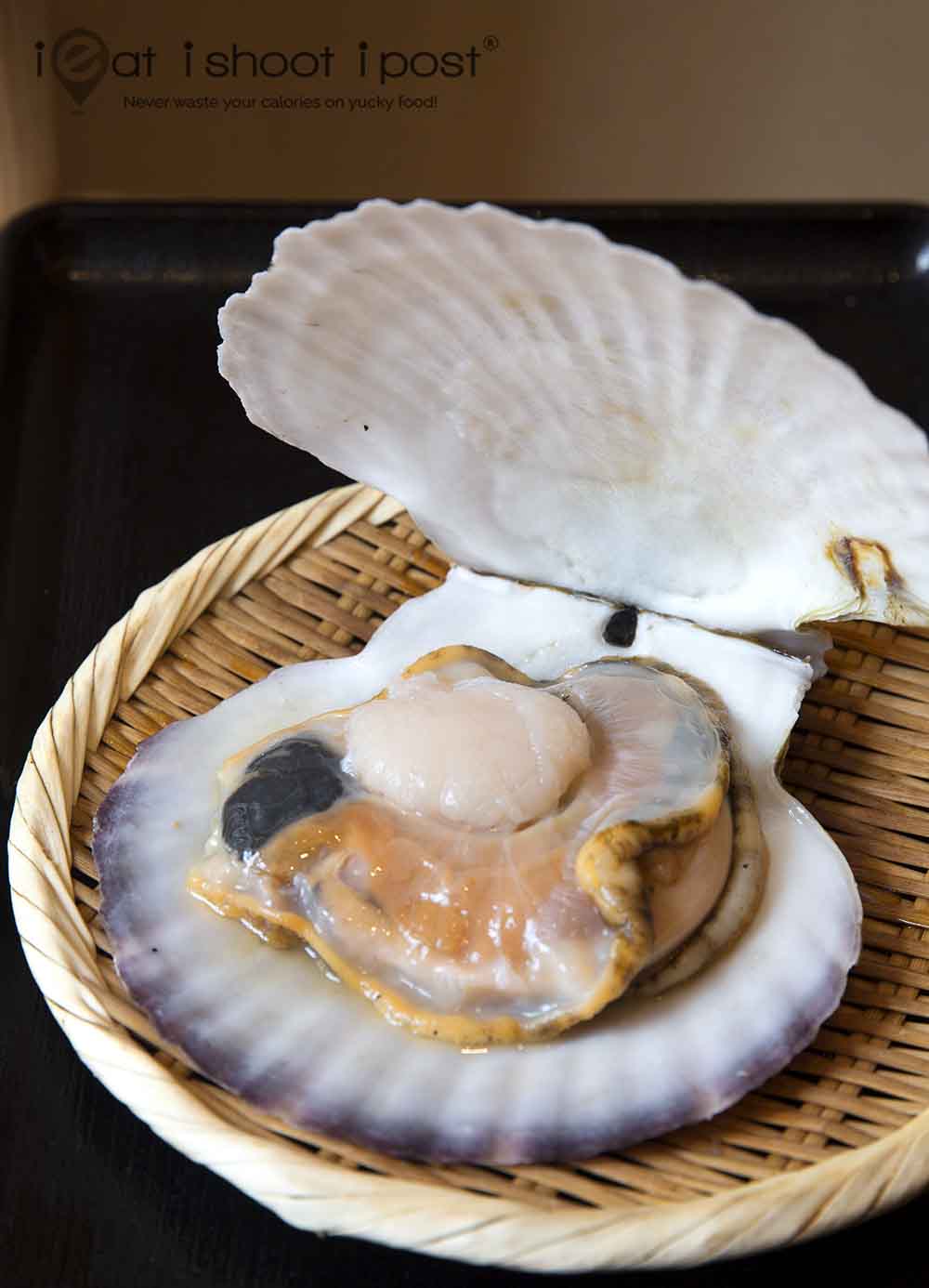
Hotategai 帆立貝
Yesso scallop
Patinopecten yessoensis

Scallops are probably the most popular shellfish on the sushi menu. It is the sweetest of all the shellfish and the texture is smooth and creamy when eaten raw. Scallops can be imported from all over the world but the sushi tsu would insist on wild Yeso (Ezo is the old name for Hokkaido) scallops, which are harvested from the frigid waters on the southern edge of the Sea of Okhotsk, north of Hokkaido. These are shipped live in the shell and are tastiest when they are four years old. The season for hotate starts from December and peaks in April where the adductor (kobashira) muscle becomes most succulent and the gonads swell to a bright reddish hue. (male gonads are orange) At its peak, the gonads are as sweet and creamy as uni and only the top sushi bars which bring in live scallops in the shell will be able to serve this as a side dish.
For more info on hotate, please read my previous article.
Acknowledgement
Thanks to Chef Ashino for helping me with this photography session. Chef Ashino specializes in aged sushi and his restaurant is one of the top spots for an authentic sushi experience! Read about Ashino here.



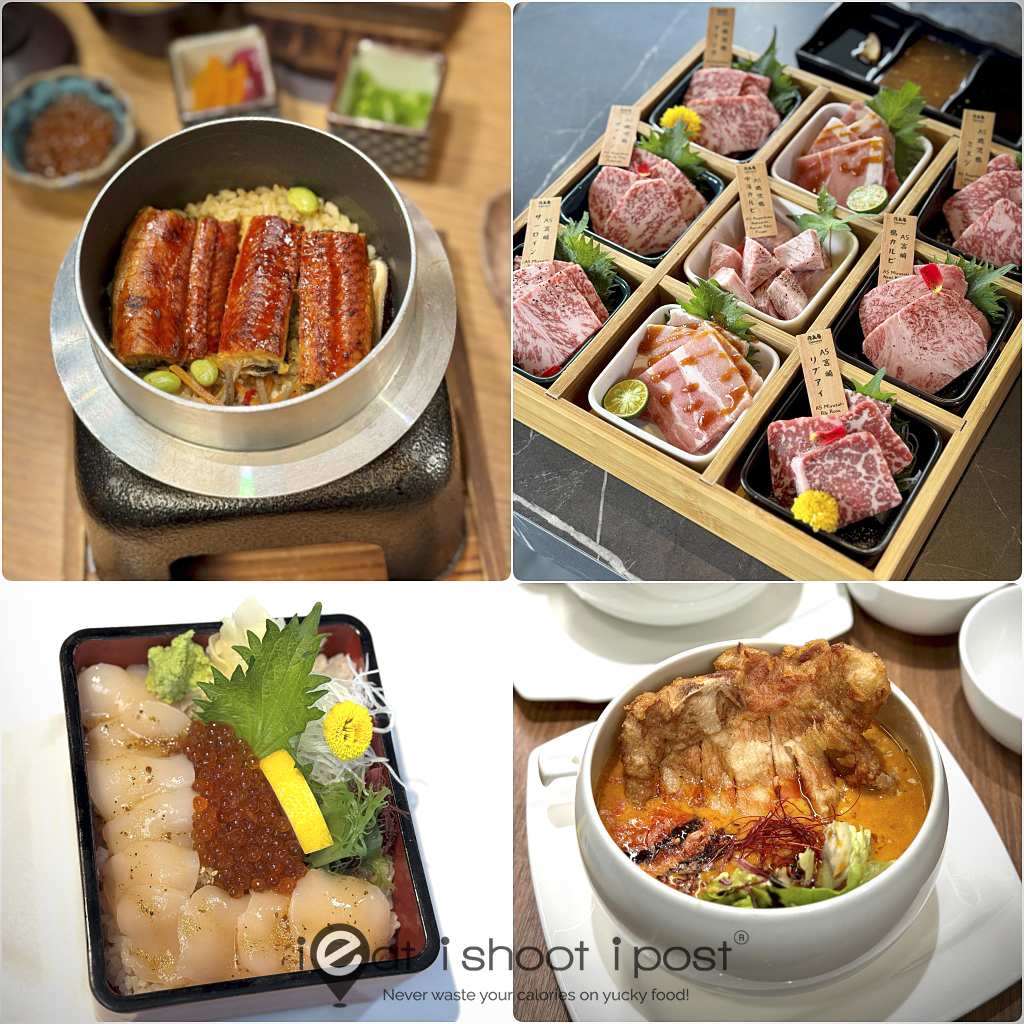
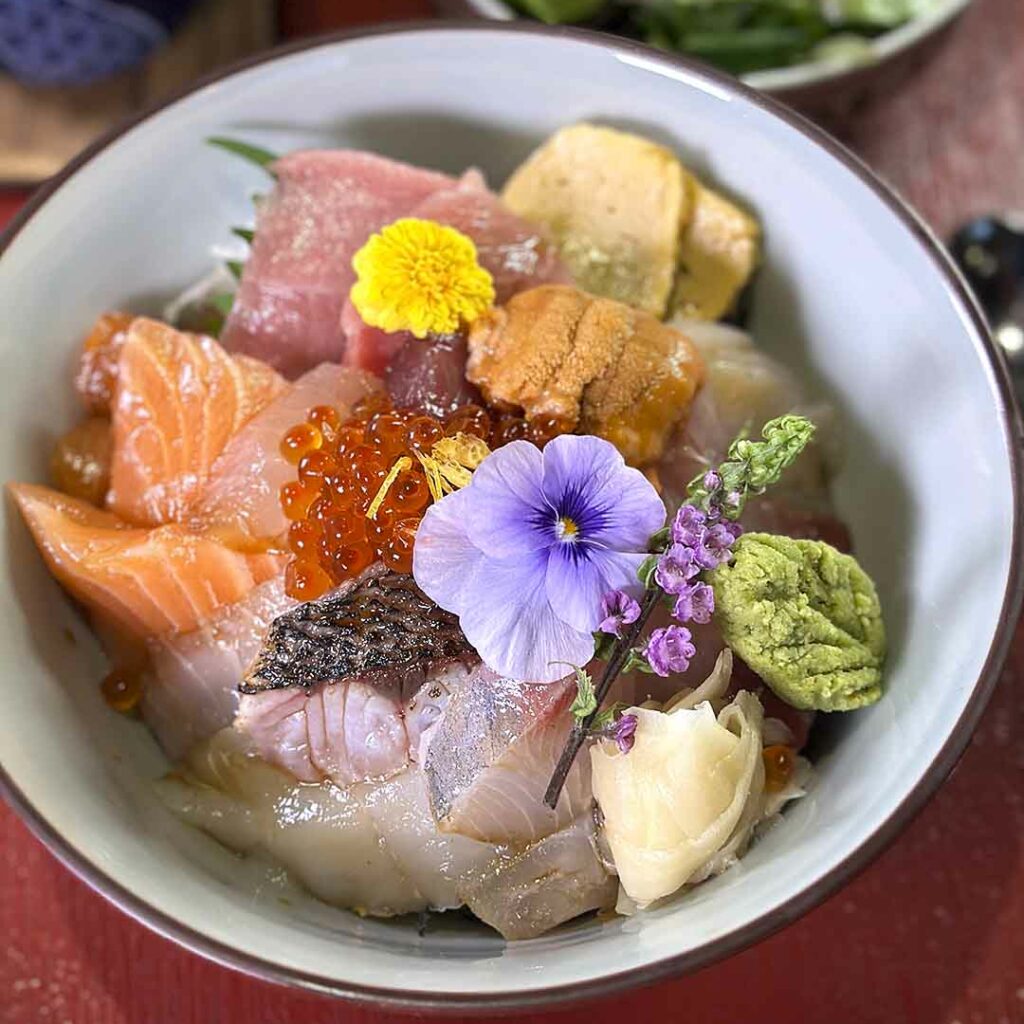
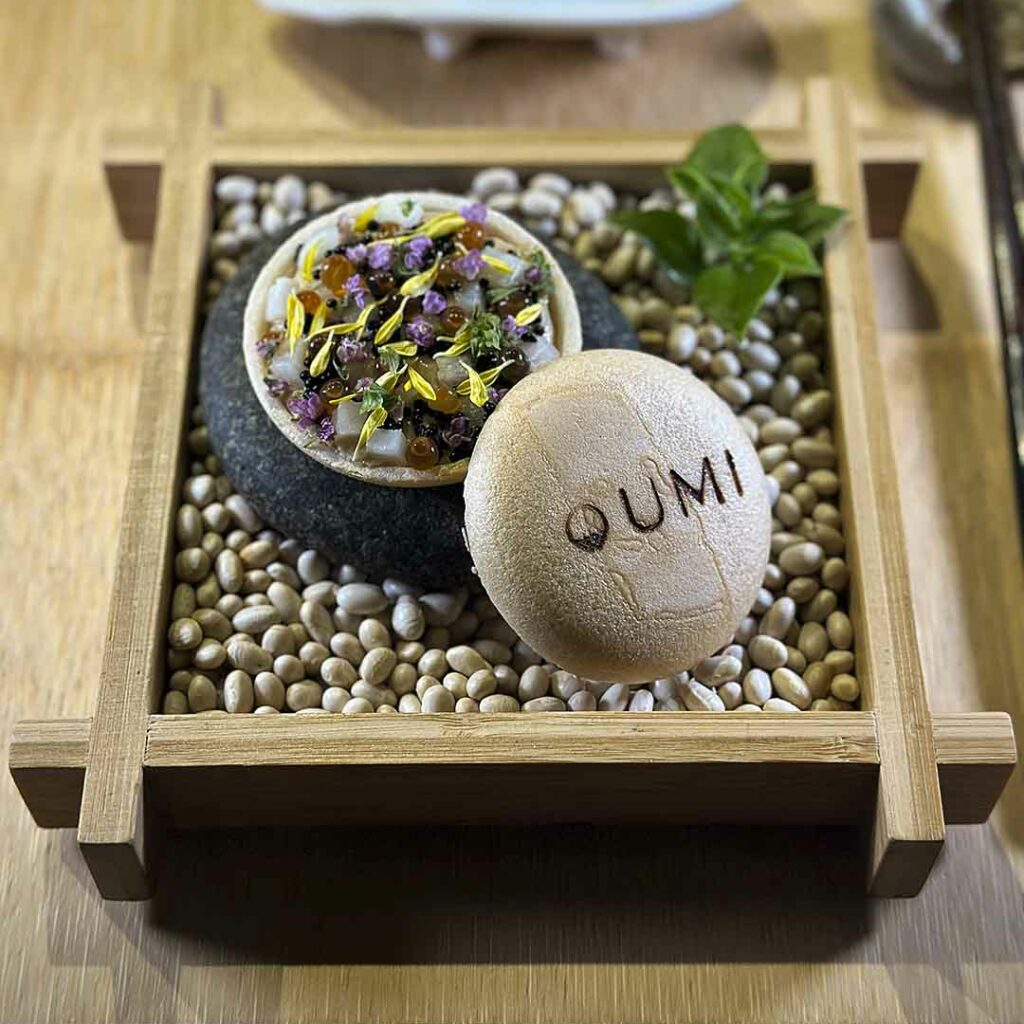
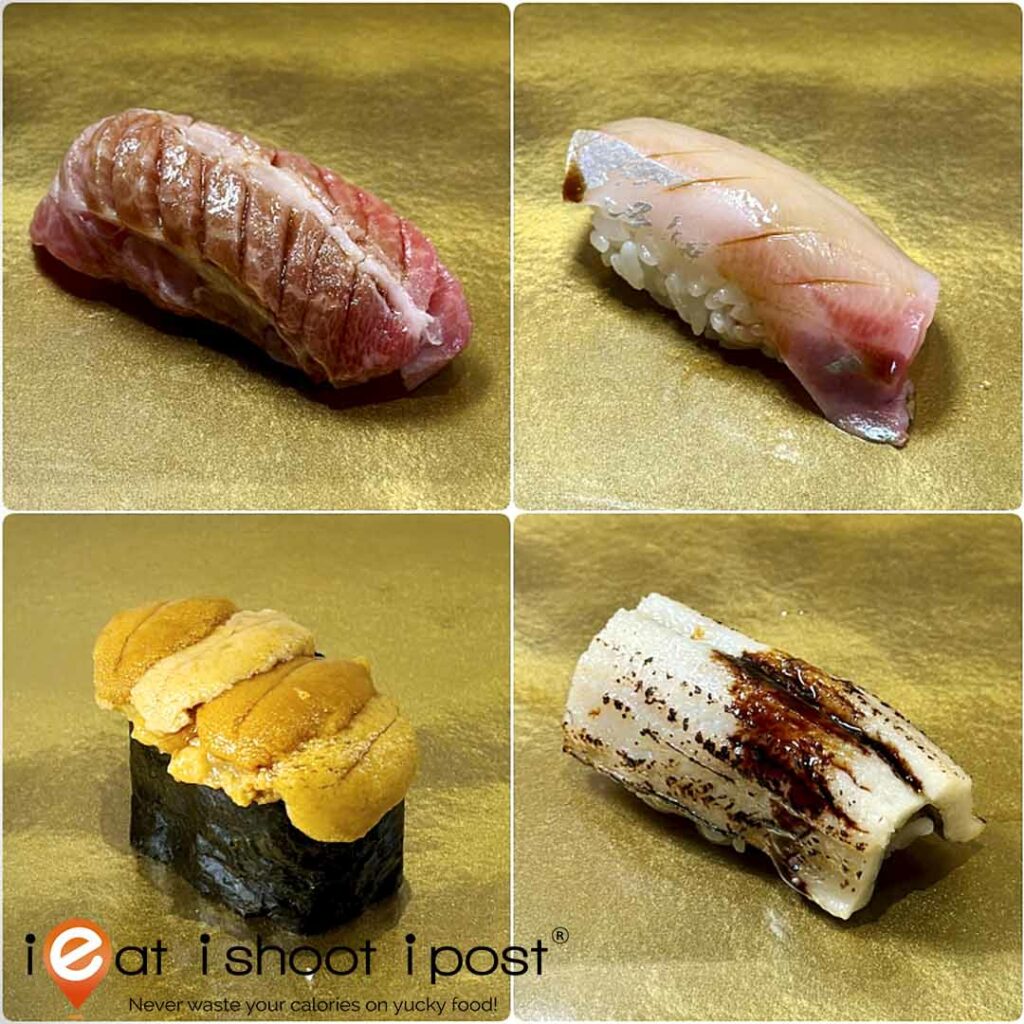
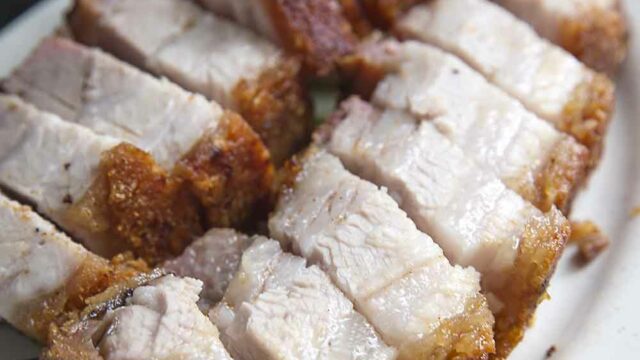




I am not a huge fan of raw consumption of filter feeders, but I’ll say the nigiri looked great.
How come? Worried about food safety or just don’t enjoy the flavour?
Yeah, food safety is a concern for me. I have been burned a couple times and it just turned me off. I will eat them if I have to (SEE Blood Cockles), but if I can avoid them I will.
Don’t blame you! I haven’t been back to K Rogers after a big GE 20 years ago!